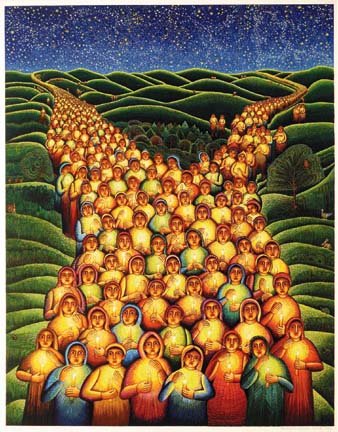JOHN AUGUST SWANSON: FESTIVAL
OF LIGHTS

The light that emanates
from the many small candle flames
illuminates
the holders’ faces, rises heavenward in a yellow glow,
and joins the
myriad of lights in the night sky. Swanson presents
to the viewer a
scene of individuals coming together to connect
to a divine source of
illumination that brightens the landscape
and the spirit of each
faithful witness.
The Brauer Museum is proud to have in
its permanent collection five wonderfully detailed screenprints on
paper by the noted and widely collected artist and illustrator John
August Swanson (b. 1938). Swanson uses his considerable technical
skills to create complex, beautifully produced prints that frequently
represent biblical subjects or narratives. In addition to these
finished prints, the Brauer Museum owns many color proofs on paper and
mylar that the artist produced and used in preparing the final
states. All of this material enables the Brauer to give viewers a
lovely overview of Swanson’s creative process in creating luminous,
rich works of graphic art.
The word "print" is confusing to many because it
seems
to indicate that a printed piece is a reproduction of some original
image such as a painting or drawing. Swanson creates
original prints, meaning that the only original that exists is the
final,
printed piece composed of many colors, each color meticulously and
painstakingly printed from individual screens prepared from unique
matrices. As the colors layer on the sheets and interact with one
another, Swanson’s images begin to glow with life. The artist’s
artistic approach is multiple by nature, with each individual
screenprint in a particular edition reflecting the multitude of careful
steps that led to its making.
Screenprinting is a process often used, for example,
for printing designs on textiles, such as items of clothing. It
is an especially versatile type of traditional printmaking that
involves an artist preparing on a silk screen through manual or
photographic means
a matrix that blocks the pores of the screen in certain areas so that
when the artist presses ink through the screen using a squeegee, the
open or unblocked areas print onto the paper
surface. Colors are printed one at a time from a number of unique
screens and matrices, meaning that the registration of many colors is a
major concern for the artist who must make sure that his forms are
clearly defined, not printed off-register in a way that might detract
from the overall design.
Swanson’s Festival
of Lights, made in the year 2000, was printed in an edition of
250, each print composed of an extraordinary 46 colors. The rich
surface of this print seems to scintillate due to its visual textures
and many layers of color-saturated ink. Valparaiso University’s
Project on the Education and Formation of People in Faith purchased
this print, number 45/250, and donated it to the Brauer Museum of Art
so that viewers might be inspired by its message and impressed by its
marvelous composition.
The labor-intensive nature of Swanson’s process is a
perfect match for the subject matter of his work. The many
figures in Festival of Lights
hold candles in a collective act of devotion. The light that
emanates from the many small candle flames illuminates the holders’
faces, rises heavenward in a yellow glow, and joins the myriad of
lights in the night sky. Swanson presents to the viewer a scene
of individuals coming together to connect to a divine source of
illumination that brightens the landscape and the spirit of each
faithful witness. His printed colors, like layers of paint that
have been carefully applied through glazing by reverent icon writers,
reflect the artist’s appreciation for his depicted subject and his deep
consideration of or fondness for his selected scene. The level of
planning involved with registering 46 colors and coordinating the color
mix and placement so that they achieve a light-filled, jewel-like
effect on the sheet seems to indicate that the artist wishes to present
to the viewer a visual prayer and even perhaps urge the viewer to
discover the lighted candle in his own heart. Swanson’s
intense yellow, artfully achieved, reaches out from the picture plane
to inspire through the complexity and care of the print’s execution.
The holders of candles in Festival of Lights all have a very
similar appearance due to the generalized representational style
Swanson uses. Particular, individual identities are not as
important for the artist’s purposes as general viewer recognition that
the assembled are all human beings communing with the majestic light
that brightens all corners of the heavens. This generalized
representational approach connects Swanson’s art with medieval sources,
since artists of that time also saw people in their specific likenesses
as secondary for their purposes to the overall divinely inspired
narrative.
The aforementioned jewel-like colors and the
stacked, vertically ascending style of perspective further connect Festival of Lights to the medieval
art that has inspired Swanson throughout his career. Art of the
medieval era, despite its typically Christian
subject matter, was heavily influenced due to historical developments
and events by middle and far eastern art; this influence manifests
itself in an emphasis on pattern, brilliant color, and shallow
pictorial space. Swanson’s print visually hearkens back to an
earlier time, but in its accessibility and inspirational message
it draws in the contemporary viewer and uses its sparkling surface to
encourage close inspection.
Swanson’s Festival
of Lights demonstrates in its virtuoso craftsmanship the level
of commitment the artist brings to the representation of a sacred
gathering. His anonymous celebrants look out from the print and
silently invite all who match their gaze to be warmed and illuminated.
© by Gregg Hertzlieb



![]()
![]()
![]()
![]()